Englert Finds Niche Market In Collegiate Boathouse Roofs
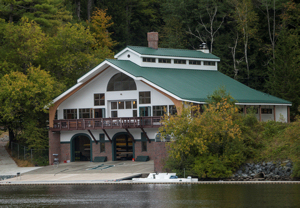 |
Today's well-appointed collegiate boathouse has elements you'd find in a fieldhouse, gymnasium, storage barn and garage all rolled into one. Shown above and below is the Friends of Dartmouth Rowing Boathouse located on the Connecticut River. Click images to enlarge. |
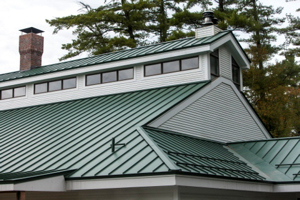 |
By Dave Rowe, Product Development Director, Englert Inc.
When you first look at the typical collegiate boathouse, you’re likely to get a little confused. When we think of boathouses, we usually think of small buildings nestled against a dock and extended over the water. The truth of the matter is that most college boathouses look more like barns or large garages. And because of the kinds of boats they house and the types of crews that use them, more often than not they aren’t located right on the water—but near it.
One other thing many of them seem to have in common is a standing seam metal roof. Durability is a primary reason for choosing metal. The buildings are constructed to house a sports program that will be active for a very long time. Plus you want a roof that you know will protect the college investment. The average eight-oared shell known as an “eight” costs about $32,000 with oars and the boathouse usually is home to several of them. So metal makes sense.
At least that was the case with boathouses we visited when we recently took a tour of boathouses in and around New England where the sport of collegiate rowing had its birthplace. Rowing was the first intercollegiate sport contested in the United States. The first rowing race was between Harvard and Yale in 1852. Yale College founded the first collegiate boat club in the U.S. in 1843. Rowers are the third largest U.S. delegation – 48 athletes – to the Olympic Games. The first amateur sport organization was a rowing club. And the first national governing body for a sport in the United States was for rowing. Founded as the National Association for Amateur Oarsmen in 1872, it was changed in 1982 to the United States Rowing Association.
Boathouses for rowing should never be confused with yacht clubs where preppy rich kids spend their entire summer socializing.
Typical of what you’ll find at a rowing boathouse is the eight-oared shells that are about 60-feet long - that’s 20 yards on a football field. An eight is made of fiberglass composite material, can carry more than three-quarters of a ton but may weigh as little as 200 pounds. Singles may be as narrow as 10 inches across, weigh only 23 pounds, and stretch nearly 27-feet long.
These are kind of craft you’ll find in the boathouses. But the buildings that house them aren’t just for storage. And like they are on fieldhouses, gymnasiums, storage barns and large garages, a standing seam metal roof is a common sight on a collegiate boathouse. That makes sense because a collegiate boathouse is often a combination of fieldhouse, gym, storage barn and garage.
 |
The Caufield Rowing Center at the U.S. Military Academy at West Point. Click images to enlarge. |
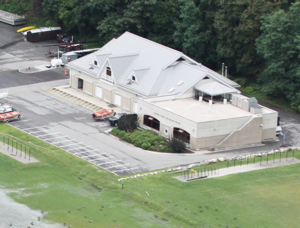 |
Take the Caufield Rowing Center at the U.S. Military Academy at West Point. There the roof is an Englert Series 2000 Dove Grey 13,000 square feet span fabricated by ADPI of Avenel, New Jersey and installed by Custom Exterior Systems, Inc. in Sloatsburg, New York. The two-story building sit yards from the Hudson River and provides space for Army Crew and Sailing operations as well as equipment storage and maintenance. It features three large bays, a repair shop, two eight-oared indoor rowing tanks, male and female locker rooms with showers, drying rooms, laundry facilities, coaches' offices, workout rooms and more. An observation deck has been added to the original design. Operations include daily practice and home races on the Hudson River. The first floor contains space for storage and maintenance of racing shells, motor launches and sailboats.
The Friends of Dartmouth Rowing Boathouse looks similar to the military academy’s boathouse. Situated just yards from the Connecticut River, it features a new 10,000 square foot Englert Series 1100 Forest Green standing seam roof, which replaced a worn, green asphalt shingle roof. The Forest Green was chosen because it is close to the college colors. Jancewicz & Sons of Bellows Falls, Vermont, installed the new roof. When they opened up the building and were removing the old roof, they found they needed to upgrade the insulation and blew in cellulose with an R-38 value. The biggest challenge, reports the installer, was the proximity of the building to the river and the constant movement of boats and their crews on land in front of the building which created limited access to portions of the structure. The boathouse is less than 10 minute walk from anywhere on campus. Like West Point and other major collegiate boathouses, the building contains a large function room, office, kitchen and deck overlooking the river. The ground floor houses over 30 racing shells for the men's, women's and men's lightweight programs. A second boathouse nearby contains a fleet of singles and pairs, a boat repair shop and the weightlifting equipment. Wind and power boats rarely disturb the crews here, with "glass" conditions most days. This combination of elements provides some of the best rowing water in the country, underscored by the fact that National Team crews have trained here every summer since 1972.
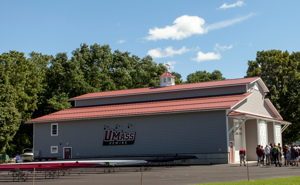 |
The University of Massachusetts boathouse in Amherst, MA. Click image to enlarge. |
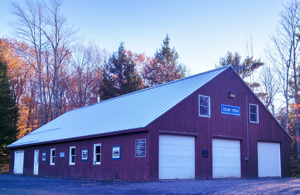 |
The Colby-Hume Center at Colby College in Waterville, Maine. Click image to enlarge. |
Two hours away and farther south on another stretch of the Connecticut River is the University of Massachusetts boathouse at Amherst. Smaller than those at Dartmouth and West Point, the UMass boathouse features three bays to store and maintain boats. At approximately 72 by 80 feet, it allows enough space for competition boats, practice boats and launches. The facility is a short distance from the water with new docks allowing easy entry to the river. Also included in the facility is a team room, showers, changing areas, and storage space for both training and competition equipment.
The structure, like at Dartmouth and West Point, features an Englert standing seam metal roof. The Series 1300 profile covers 6,000 square feet of roof area and is Colonial Red, similar to UMass’ maroon school color.
The last of our four boathouses is the Colby-Hume Center at Colby College in Waterville, Maine. It’s located seven miles from campus, on a 10-acre parcel of land with 450 feet of shoreline on Messalonskee Lake. The boathouse, like the one at UMass, resembles a barn structure, and is used by the men's and women's crews and the sailing club team. Woodworking and blacksmith shops located at the Center are used by students during January. The boathouse features a new Englert Series 1300 standing seam roof. The 5,100 square foot roof span features a GalvalumePlus mill finish and was installed by C. O. Beck & Sons of Waterville, Maine.
About Englert Inc.
 Englert Inc. is a developer of commercial and residential metal roofing and gutter systems, and supports a contractor network with the machinery and
materials to produce them on site. To learn more, visit www.englertinc.com.
Englert Inc. is a developer of commercial and residential metal roofing and gutter systems, and supports a contractor network with the machinery and
materials to produce them on site. To learn more, visit www.englertinc.com.